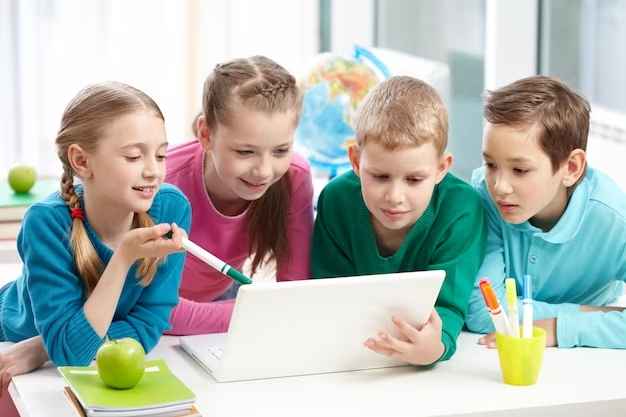Introduction
In the rapidly evolving landscape of education, technology has become an integral part of early childhood education for preschoolers . While there are concerns about screen time and its potential impact, when used judiciously, technology can offer numerous benefits in fostering the holistic development of young minds. This article explores the multifaceted role technology plays in early childhood education and how it can be a valuable tool for enhancing the learning experiences of preschoolers.
1. Interactive Learning Apps and Games
Technology provides access to a plethora of interactive learning applications and games designed specifically for preschoolers. These apps often focus on foundational skills such as letter recognition, basic numeracy, and language development. With colorful graphics, engaging animations, and interactive features, these apps make learning enjoyable, capturing the attention of young learners and turning educational activities into playful experiences.
2. Digital Storytelling Enhances Literacy Skills
Digital storytelling apps and e-books contribute significantly to literacy development in preschoolers. These tools often incorporate interactive elements, allowing children to engage with the story by tapping, swiping, or participating in decision-making within the narrative. This not only enhances their understanding of language but also promotes critical thinking and comprehension skills.
3. Virtual Field Trips Expand Horizons
Technology facilitates virtual field trips that can transport preschoolers to places they might not otherwise have the opportunity to visit. Whether exploring the depths of the ocean, taking a virtual tour of a zoo, or visiting different countries, these virtual experiences provide a visual and interactive learning environment. This exposure broadens their horizons and nurtures curiosity about the world around them.
4. Educational Videos and Multimedia Content
Well-designed educational videos and multimedia content catered to preschoolers can be powerful tools for learning. Platforms like YouTube Kids offer a variety of age-appropriate content covering topics from science experiments to nursery rhymes. These videos can reinforce concepts introduced in the classroom, making learning more dynamic and engaging.
5. Development of Fine Motor Skills through Touchscreen Devices
The use of touchscreen devices, such as tablets, can contribute to the development of fine motor skills in preschoolers. Dragging, tapping, and swiping on screens require hand-eye coordination and precise finger movements, which can be beneficial for refining motor skills. Many educational apps are designed to incorporate these interactive features, making the learning process both educational and physically engaging.
6. Customized Learning Experiences
Technology allows for personalized and adaptive learning experiences based on individual progress. Educational software can assess a child's strengths and areas that need improvement, adjusting the difficulty level accordingly. This customization ensures that each preschooler receives tailored instruction, allowing them to learn at their own pace and in a way that suits their unique learning style.

How to reduce screen time for kids:
While acknowledging the positive role of technology in early childhood education, it is crucial to address the concern of excessive screen time. Parents and educators alike are increasingly aware of the importance of maintaining a balance between digital interactions and other forms of play and learning. To mitigate the potential drawbacks associated with prolonged screen exposure, intentional efforts should be made to reduce screen time for kids.
Encouraging outdoor activities, hands-on creative play, and physical games can provide alternative avenues for learning and development. Establishing clear and consistent screen time limits, coupled with the creation of tech-free zones within the home, can help foster a healthier balance. Additionally, engaging in joint activities, such as reading books together or participating in interactive, non-screen-based educational games, offers valuable opportunities for bonding while minimizing screen reliance. By promoting a holistic approach that combines the benefits of technology with diverse offline experiences, parents and educators can ensure that preschoolers develop into well-rounded individuals with a healthy relationship with the digital world.
Related : Discovering the Top 10 Montessori Schools in Los Angeles
As we explore the dynamic landscape of early childhood education and the integration of technology, it's essential to highlight noteworthy institutions that embody progressive and effective teaching methodologies. Among these is Montessori Shir-Hashirim in Los Angeles, a beacon of educational excellence. Let's delve into how this esteemed institution aligns with the principles of holistic development and interactive learning that we've discussed, offering a unique approach to preschool education that prepares young minds for a bright future.
Montessori Shir-Hashirim Los Angeles
- 6047 Carlton Way, Los Angeles, CA 90028
- Highly rated for focused curriculum, excellent staff, and diverse extracurriculars
- Half day: $27,000 yearly, $9,000 quarterly
- Full day: $28,500 yearly, $9,500 quarterly
Shir-Hasirim Montessori school has two different locations. The main location is on Carlton Way in Los Angeles. This school teaches children between the ages of 2 and 6 and prepares them for some of the top Montessori elementary schools in the city. Specifically, they offer a primary program and a summer program for preschool children.
At Shir-Hashirim, they allow their students to grow and learn both individually and within the community of the school. Students are able to learn at their own pace when it comes to both practical life skills and subjects such as maths and language. Shir-Hashirim Montessori has a parent-and-me program that is required for families who may enrol their child in the Montessori program.
Conclusion
In conclusion, technology, when thoughtfully integrated, plays a pivotal role in early childhood education for preschoolers. The key lies in balancing screen time with other forms of hands-on, experiential learning. The interactive and dynamic nature of educational technology can captivate the attention of young learners, making the educational process more enjoyable and effective. As we navigate the digital age, harnessing the positive aspects of technology in early childhood education can pave the way for well-rounded, tech-savvy individuals who are not only academically proficient but also equipped with essential skills for the future.


